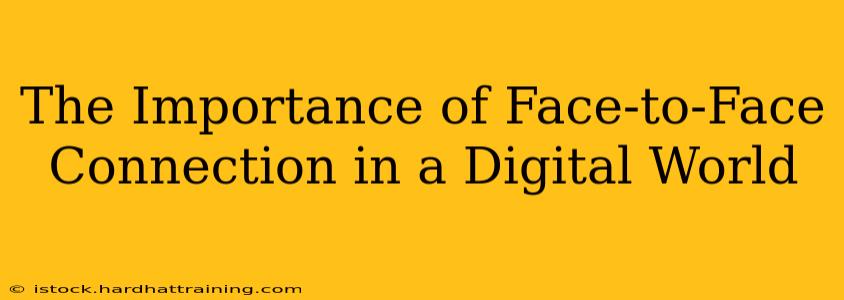The digital age has revolutionized communication, connecting us across continents with unparalleled speed and ease. Yet, amidst this hyper-connectivity, a crucial element of human interaction risks being sidelined: the importance of face-to-face connection. While digital tools offer efficiency and convenience, they cannot fully replicate the richness and depth of in-person communication. This article explores the enduring significance of face-to-face interaction in a world increasingly dominated by screens.
Why is Face-to-Face Interaction Still Important?
In a world dominated by emails, instant messaging, and video conferencing, the value of face-to-face interaction might seem diminished. However, the truth is quite the opposite. Direct, in-person communication fosters a level of understanding and connection that digital platforms simply can't match. This is due to a number of factors:
-
Nonverbal cues: A significant portion of communication is nonverbal – body language, facial expressions, tone of voice. These subtle cues are easily missed or misinterpreted in digital interactions, leading to misunderstandings and missed opportunities for genuine connection. Face-to-face communication allows for the full spectrum of communication to be received and processed, resulting in richer interactions.
-
Building trust and rapport: Trust is built through shared experiences and personal interactions. While digital communication can help maintain relationships, it's the face-to-face interactions that build the strongest bonds. The shared physical space creates a sense of intimacy and shared experience, crucial for developing strong relationships, both personal and professional.
-
Enhanced collaboration and creativity: In-person collaboration sparks creativity and innovation. The spontaneous exchange of ideas, brainstorming sessions, and the ability to read each other's body language all contribute to a more dynamic and productive collaborative environment. This is particularly crucial in teams and projects that require a high degree of synergy.
-
Improved empathy and understanding: Face-to-face encounters allow for a deeper understanding of another person's emotions and perspectives. Seeing someone's facial expressions and body language provides valuable context that is often lost in written or even video communication. This enhanced empathy fosters stronger relationships and promotes better conflict resolution.
How Can I Improve My Face-to-Face Communication Skills?
Mastering face-to-face communication is a skill, and like any skill, it can be improved with practice and conscious effort. Here are some key strategies:
-
Active listening: Pay close attention not just to the words being spoken but also to the speaker's nonverbal cues. Show genuine interest by maintaining eye contact, nodding, and providing verbal affirmations.
-
Clear and concise communication: Structure your thoughts and articulate your ideas clearly and concisely. Avoid jargon or overly technical language that might confuse the other person.
-
Nonverbal awareness: Be mindful of your own body language. Maintain open posture, make appropriate eye contact, and use hand gestures to emphasize your points.
-
Empathy and perspective-taking: Try to understand the other person's point of view, even if you don't agree with it. Show empathy and respect for their feelings and opinions.
-
Practice makes perfect: The more you practice face-to-face communication, the more comfortable and confident you will become.
What are the Disadvantages of Relying Solely on Digital Communication?
Over-reliance on digital communication can have several drawbacks:
-
Misinterpretations and misunderstandings: The absence of nonverbal cues can lead to misinterpretations of messages, causing conflict and damaged relationships.
-
Reduced empathy and connection: Lack of face-to-face interaction can hinder the development of empathy and deeper connections with others.
-
Increased feelings of isolation and loneliness: While digital communication connects us, it can also contribute to feelings of isolation and loneliness if it replaces genuine human interaction.
-
Reduced productivity and collaboration in certain contexts: For tasks that require high levels of collaboration and creativity, digital communication can be less effective than in-person interaction.
Is Face-to-Face Communication More Effective Than Digital Communication?
The effectiveness of face-to-face versus digital communication depends on the context. While digital communication is efficient for conveying information and scheduling meetings, face-to-face communication is generally more effective for building relationships, resolving conflicts, and fostering collaboration. The ideal approach often involves a balanced combination of both.
How Can I Balance Digital and Face-to-Face Communication?
Finding the right balance between digital and face-to-face communication requires intentionality. Consider the context of the communication. For quick updates or informational exchanges, digital tools are efficient. For relationship-building, conflict resolution, or collaborative problem-solving, prioritize face-to-face interactions. Schedule regular in-person meetings, even if just for brief check-ins, to maintain strong connections.
In conclusion, despite the advances in digital communication, the importance of face-to-face connection remains undeniable. It's a cornerstone of building strong relationships, fostering collaboration, and achieving a deeper understanding of one another. By consciously integrating both forms of communication, we can leverage the strengths of both to navigate the complexities of the modern world.
